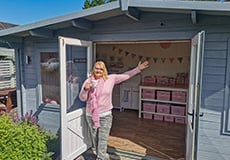It’s important to do business with ethically responsible companies, especially when resources are dwindling. Dunster House, a market leader in wooden garden structures, is committed to sustainability and well managed forest resources. As a member of Timber Development UK (TDUK), Dunster House is committed to ensuring procurement of timber and manufactured forest products from legal and well-managed forests. Sustainability is very important to us here at Dunster House.
.png)
We also comply with UK Timber Regulations (UKTR) and EU Timber Regulations (EUTR).
This sustainability policy applies to all timber purchases from the UK and overseas.
Wherever possible, our preference are companies that are FSC (Forest Stewardship Council) or PEFC (Programme for the Endorsement of Forest Certification) certified.
As a cornerstone of this commitment, we pursue a Responsible Purchasing Policy (RPP).
This is to promote the use and marketing of legal and environmentally responsible forest products. This will hopefully further awareness of the importance of sustainability.
Committed to improving sustainability
Dunster House is committed to continuously improve the sustainability level of our sourcing, by favouring stricter more credible certification and verification standards, and sourcing requirements. We are committed to avoiding sourcing from unknown or unsustainable sources.
We truly believe that every business can make a global impact, and are working hard to try and make this world a safer and better place. In the past years, we have become one of the leading manufacturers of sanitation equipment for national and international charities, being an official supplier of many major Non-Government Organisations (NGOs).
Environmental concerns are something that should be considered in all areas. In the last few decades, the exploitation of our planet and degradation of our environment has gone up at an alarming rate. Thus the importance of an eco-friendly ethos and sustainability within a company is vital. Even the smallest of changes will contribute towards making an impact in saving our planet.
As a wooden garden building manufacturer and supplier, we try our best to reduce environmental issues that are in our control. Where we can, we adopt eco-friendly practices throughout various stages of our business. We do our best to be as sustainable as possible for our customers.
At our headquarters, we even use a biomass boiler to heat our offices when necessary.
Reasons sustainable timber is the best construction material
1. Carbon capture and storage
Trees absorb carbon through photosynthesis. When they die and decompose, most of the carbon they’ve stored is released back into the atmosphere. This has a neutral impact on atmospheric carbon levels over the lifetime of the tree
Most people assume that cutting trees down for use in construction will be bad for the environment and climate because fewer trees will be around to absorb carbon from the air.
This is true if you’re talking about traditional logging, which is destructive. However, with sustainable forestry, as many new trees are grown as are harvested. So when trees are harvested, their carbon is stored in the timber, and they are replaced by new young trees. This results in net carbon removal from the atmosphere, which is good for the environment.
Around a tonne of carbon is stored in every metre cubed of timber. Even better, trees actually absorb carbon very rapidly while they are growing, and absorb less as they age.
This means that sustainably managed forests where sustainable timber is harvested and replaced can potentially be an even more effective carbon store than an undisturbed forest.
2. Low embodied energy
Sustainable timber has the lowest embodied energy of any mainstream building material. And far less than for steel, concrete or aluminium. This is mainly because timber requires only minimal processing compared to other materials. This has the potential to make a huge impact on the carbon footprint of a building.
Its processing also emits less sulphur dioxide, carbon monoxide, hydrocarbons, particulate matter and VOCs than competing materials.
3. Truly renewable
Looking to the longer term, one of the biggest advantages of sustainable timber is that it is obviously a naturally renewable material.
A tree can be grown to a suitable harvest size in 25 to 80 years. While the raw materials for bricks, steel and plastics are only renewed over geological time – i.e. finite in human terms.
4. Durable and easily maintained
Sustainable timber is a highly durable material. Some well-made wooden structures last for centuries, such as the timber frames of many Tudor buildings. It is also easy and cheap to maintain compared to other materials. Especially if you don’t mind it changing its colour over time.
It is also a very strong material with good structural properties, being suitable for up to eight storey buildings (and new innovations are now even allowing timber to be used for high-rises!)
Surprisingly, despite its use as fuel, timber has good fire resistance. This is because it burns in a much more predictable way than steel which dramatically collapses after a ‘flash point’ is reached.
5. Beautifully aesthetic
Wood is a universally popular material that is widely agreed to offer a warm and comforting aesthetic. As a natural material, it also has the benefit of helping a structure to blend in with its landscape, especially in rural areas. This gentle visual impact can sometimes help projects get planning approval in sensitive sites.
6. Highly versatile
As well as being naturally beautiful, wood is also extremely versatile. Different species of tree produce timber of differing colours, textures and functional qualities. Wood also competes with plastic in its enormously wide range of applications. From structural frames to exterior cladding and joinery, and from decorative finishes to furniture.
7. Quick and simple build
Timber-framed buildings are far quicker to erect than brick or stone buildings. A quicker build time clearly saves time and money for both domestic and commercial property owners. Building with sustainable timber is also a less specialised and expensive skill – carpenters are typically more affordable than other skilled trades such as bricklayers.
8. Good insulation
A sustainable timber frame allows more space for insulation than a brick building, and wood itself also has naturally thermally insulating properties.
Of course, a better insulated home requires less energy to heat and cool, which typically means less fossil fuel use (and also costs the occupiers less, being particularly beneficial to those on low incomes).
This acts as an indirect reduction of carbon emissions, in addition to the carbon capture and storage of the timber itself and the emissions saved from replacing other more energy intensive material

We always make sure to stay abreast of the latest developments which will help us further reduce the environmental impact of our timber buildings. In projects we work on, we encourage clients to make use of the wide range of cutting-edge, energy-saving technologies. Not to brag, of course, we just want you to know that we’re doing our bit! If you want to do your bit check out our How to Make your Garden Sustainable blog!





